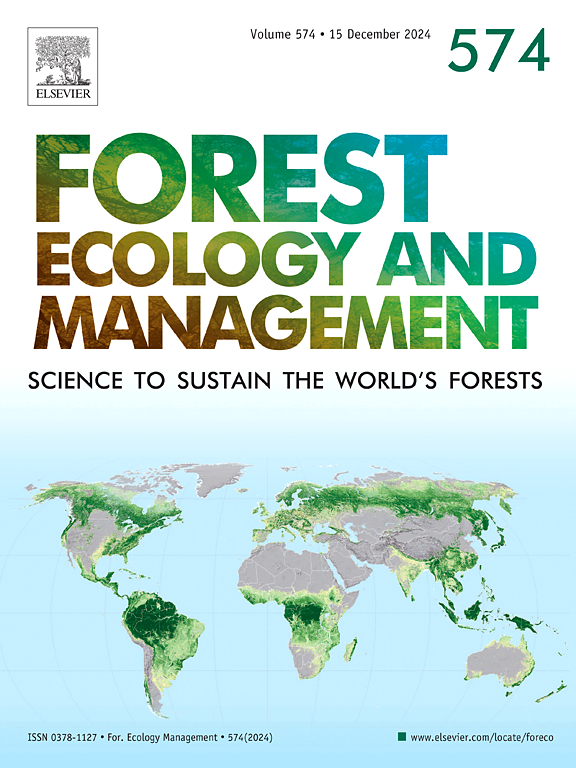五龄或五龄以下小叶松的生长趋势与土壤类型和管理强度的关系
IF 3.7
2区 农林科学
Q1 FORESTRY
引用次数: 0
摘要
我们评估了五龄或五龄以下小叶松(Pinus taeda L.)的三个目标:1)不同土壤类型和造林强度对高度生长的影响;2)使用一至五龄高度预测基龄 25 地块指数(SI25)的准确性;3)轮伐初期表现出的高度优势是否会在整个轮伐期间保持。研究使用了美国东南部 42 个地点的数据,这些地点的土壤质地和管理强度(最佳、密集和操作)各不相同。管理强度和土壤对树高的影响很大。粗壤土对管理强度的增加反应最大。四龄时,最优组的树高最高(4.63 米),其次是强化组(4.31 米),然后是操作组(3.06 米)。有机土壤似乎对最大管理强度没有反应。SI25 的可预测性很高,尤其是从四龄开始,四龄密集组的 R2 值为 0.27,四龄操作组的 R2 值为 0.78。最佳组的坡度最大,在二龄、三龄、四龄或五龄时,每增加一米高度,场地指数预计将分别增加 2.61 米、2.75 米、1.88 米和 1.78 米。来自六个不同研究地点的数据表明,随着时间的推移,最高(一级)和最小(五级)的树木改变百分位数等级的频率最低。早在两岁时,超过 40% 的一等和五等观测值在 13 岁时等级变化为零。幼树数据可有效预测 SI25,而高度优势似乎在轮伐初期就已形成。本文章由计算机程序翻译,如有差异,请以英文原文为准。
Growth trends of loblolly pine age five or less in relation to soil type and management intensity
We evaluated three objectives for loblolly pine (Pinus taeda L.) trees age five or less: 1) how height growth varies by soil type and silvicultural intensity, 2) the accuracy of predicted base-age 25 site index (SI25) using age one to five heights, and 3) if height dominance exhibited early in the rotation is maintained throughout the rotation. Data from 42 sites across the southeastern United States with an array of soil textures and management intensities (optimal, intensive, and operational) were used. Management intensity and soils significantly affected tree height. Coarse loamy soils were the most responsive to increasing management intensity. At age four, tree heights were greatest in the optimal group (4.63 m), followed by the intensive (4.31 m), and then the operational (3.06 m). Organic soils do not appear to respond to maximum management intensity. Predictability of SI25 was high especially starting at age four, with R2 values ranging from 0.27 for the age four intensive group to 0.78 for the age four operational group. The optimal group had the greatest slope with an expected increase of 2.61, 2.75, 1.88, and 1.78 m in site index per additional meter of height at ages two, three, four, or five, respectively. Data from six different study sites indicate, the tallest (class one) and smallest (class five) trees changed percentile class the least often over time. As early as age two, over 40 % of observations in classes one and five had zero changes in class through age 13. Young tree data were effective in predicting SI25, and height dominance appeared generally set early in the rotation.
求助全文
通过发布文献求助,成功后即可免费获取论文全文。
去求助
来源期刊

Forest Ecology and Management
农林科学-林学
CiteScore
7.50
自引率
10.80%
发文量
665
审稿时长
39 days
期刊介绍:
Forest Ecology and Management publishes scientific articles linking forest ecology with forest management, focusing on the application of biological, ecological and social knowledge to the management and conservation of plantations and natural forests. The scope of the journal includes all forest ecosystems of the world.
A peer-review process ensures the quality and international interest of the manuscripts accepted for publication. The journal encourages communication between scientists in disparate fields who share a common interest in ecology and forest management, bridging the gap between research workers and forest managers.
We encourage submission of papers that will have the strongest interest and value to the Journal''s international readership. Some key features of papers with strong interest include:
1. Clear connections between the ecology and management of forests;
2. Novel ideas or approaches to important challenges in forest ecology and management;
3. Studies that address a population of interest beyond the scale of single research sites, Three key points in the design of forest experiments, Forest Ecology and Management 255 (2008) 2022-2023);
4. Review Articles on timely, important topics. Authors are welcome to contact one of the editors to discuss the suitability of a potential review manuscript.
The Journal encourages proposals for special issues examining important areas of forest ecology and management. Potential guest editors should contact any of the Editors to begin discussions about topics, potential papers, and other details.
 求助内容:
求助内容: 应助结果提醒方式:
应助结果提醒方式:


